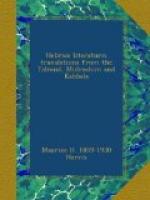If in time of national calamity a man withdraw himself from his kindred and refuse to share in their sorrow, his two guardian angels come and lay their hands upon his head and say, “This man has isolated himself from his country in the day of its need, let him not live to see and enjoy the day when God shall restore its prosperity.” When the community is in trouble, let no man say, “I will go home and eat and drink, and say, Peace be unto thee, oh my soul!” (Luke xii. 19); for to him Scripture hath solemnly said (Isa. xxii. 13, 14), “Surely this iniquity shall not be purged from you till you die.”
Taanith, fol. 11, col. 1.
An infant that has died under a month old is (to be) carried to the grave in the arms (not in a coffin), and buried by one woman and two men, but not by one man and two women.
Moed Katan, fol. 24, col. 1.
Both Rashi and the Tosephoth allude to a case which justifies the rule given here, where a woman actually carried a living child in a coffin, in order to avoid the suspicion of an assignation she had made with a man, who set out to join her. But the Tosephoth, after noticing this version of Rashi, gives another more to the point. The story in the Tosephoth is to this effect:—A woman was once weeping and groaning over the grave of her husband, and not very far away was a man who was guarding the corpse of a person who had been crucified. In the moment of mourning an affection sprung up between the two, and in the engrossment of it the corpse which the man guarded was stolen. He was in great trepidation for fear of the king’s command. The woman said, “Don’t be afraid; exhume my husband, and hang him up instead.” This was accordingly done. (See Kiddushin, fol. 80, col. 2.)
There were two date trees in the Valley of Hinnom from between which smoke ascended, and this is the gate of hell.
Succah, fol. 32, col. 2.
According to Jewish tradition, there are three gates to Gehinnom, one in the desert, one in the sea, and one in Jerusalem: In the desert, as it is written (Numb. xvi. 33), “They went down, and all that belonged to them, alive into hell.” In the sea, as it is written (Jonah ii. 2), “Out of the belly of hell have I called,” etc. In Jerusalem, as it is written (Isa. xxxi. 9), “Thus saith the Lord, whose fire is in Zion, and His furnace in Jerusalem.”




